tires TOYOTA YARIS 2019 Owners Manual (in English)
[x] Cancel search | Manufacturer: TOYOTA, Model Year: 2019, Model line: YARIS, Model: TOYOTA YARIS 2019Pages: 600, PDF Size: 6.11 MB
Page 5 of 600

5
1
8 7
6 4 3
2
YARIS SEDAN_OM_OM99S50z_(U)
5
5-1. Essential InformationIntroduction ....................... 432
5-2. Scheduled Maintenance Maintenance Monitor......... 434
5-3. Owner Maintenance Owner Maintenance Precautions ..................... 437
Hood.................................. 439
Engine Compartment Overview ......................... 441
Engine Oil.......................... 442
Engine Coolant.................. 445
Brake/Clutch Fluid ............. 448
Window Washer Fluid ....... 449
Body Lubrication ............... 450
Wiper Blades ..................... 451
Battery ............................... 454
Key Battery Replacement ................... 456
Tires .................................. 459
Light Bulbs ........................ 465
Fuses ................................ 475
5-4. Appearance Care Exterior Care ..................... 482
Interior Care ...................... 490 6-1. Parking in an Emergency
Parking in an Emergency ...................... 496
6-2. Flat Tire Spare Tire and Tool Storage ............................ 497
Changing a Flat Tire .......... 501
6-3. Battery Runs Out Jump-Starting .................... 511
6-4. Emergency Starting Starting a Flooded Engine ............................. 515
Push-Starting ..................... 516
6-5. Overheating Overheating ....................... 517
6-6. Emergency Towing Towing Description ............ 519
Tiedown Hooks .................. 520
6-7. Warning/Indicator Lights and Warning Sounds
If a Warning Light Turns On or Flashes .................. 522
Message Indicated on Display............................. 533
Warning Sound is Activated.......................... 535
6-8. When Trunk Lid Cannot be Opened
When Trunk Lid Cannot be Opened....................... 539
5Maintenance and Care6If Trouble Arises
Page 16 of 600
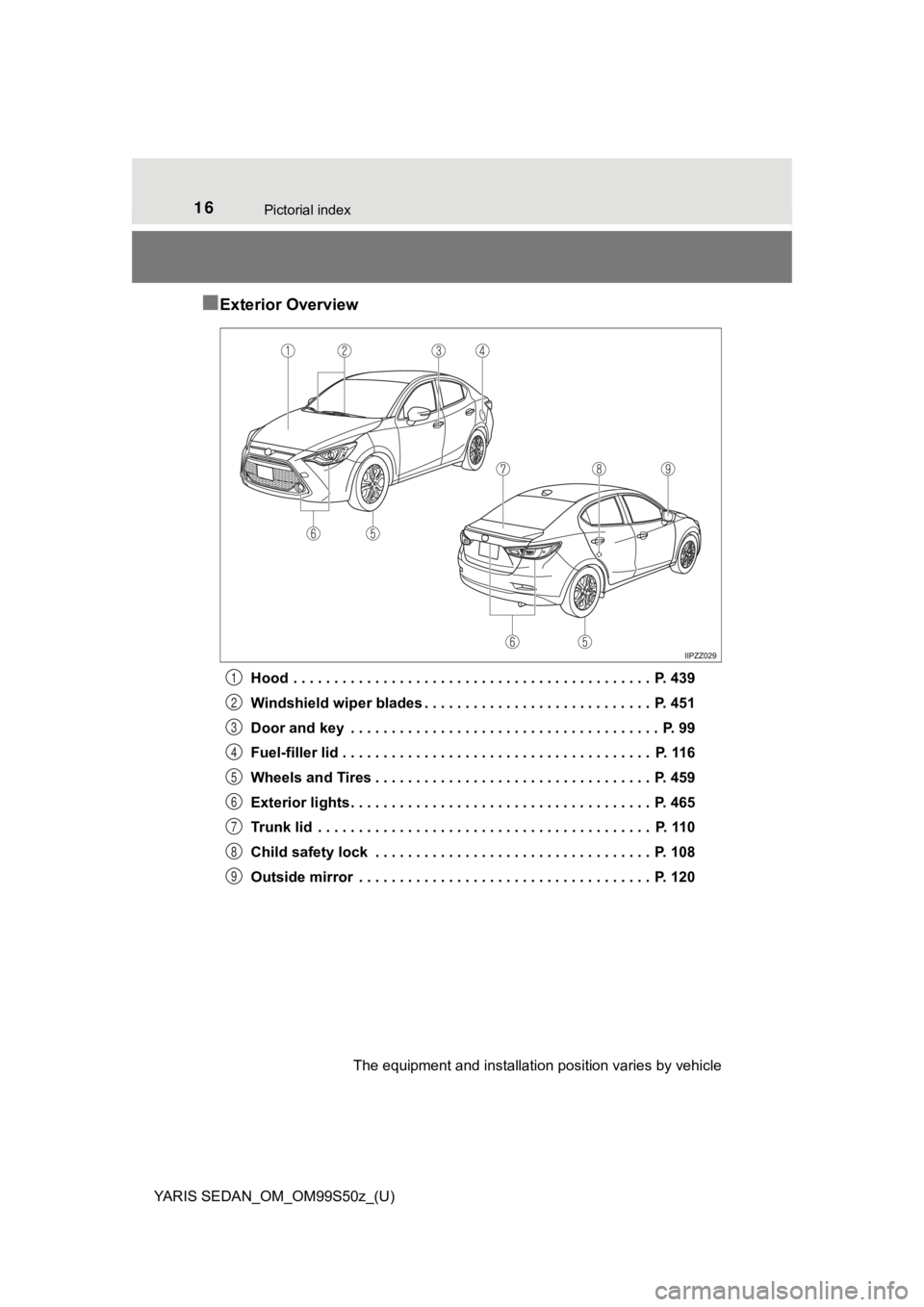
16Pictorial index
YARIS SEDAN_OM_OM99S50z_(U)
■Exterior Overview
Hood . . . . . . . . . . . . . . . . . . . . . . . . . . . . . . . . . . . . . . . . . . . . P. 439
Windshield wiper blades . . . . . . . . . . . . . . . . . . . . . . . . . . . . P. 451
Door and key . . . . . . . . . . . . . . . . . . . . . . . . . . . . . . . . . . . . . . P. 99
Fuel-filler lid . . . . . . . . . . . . . . . . . . . . . . . . . . . . . . . . . . . . . . P. 116
Wheels and Tires . . . . . . . . . . . . . . . . . . . . . . . . . . . . . . . . . . P. 459
Exterior lights . . . . . . . . . . . . . . . . . . . . . . . . . . . . . . . . . . . . . P. 465
Trunk lid . . . . . . . . . . . . . . . . . . . . . . . . . . . . . . . . . . . . . . . . . P. 110
Child safety lock . . . . . . . . . . . . . . . . . . . . . . . . . . . . . . . . . . P. 108
Outside mirror . . . . . . . . . . . . . . . . . . . . . . . . . . . . . . . . . . . . P. 120
The equipment and installation position varies by vehicle
1
2
3
4
5
6
7
8
9
Page 66 of 600

66
YARIS SEDAN_OM_OM99S50z_(U)
1-4. SRS Air Bags
WARNING
■Do not touch the components of t he supplemental restraint system
after the air bags have inflated
Touching the components of the supplemental restraint system af ter the air
bags have inflated is dangerous. Immediately after inflation, t hey are very
hot. You could get burned.
■ Never install any front-end equipment to your vehicle
Installation of front-end equipment, such as frontal protection bar (kangaroo
bar, bull bar, push bar, or other similar devices), snowplow, o r winches, is
dangerous. The air bag crash sensor system could be affected. T his could
cause air bags to inflate unexpectedly, or it could prevent the air bags from
inflating during an accident. Front occupants could be seriously injured.
■ Do not modify the suspension
Modifying the vehicle suspension is dangerous. If the vehicle’s height or the
suspension is modified, the vehicle will be unable to accurately detect a col-
lision or roll-over accident resulting in incorrect or unexpect ed air bag
deployment and the possibility of serious injuries.
■ To prevent false detection by t he air bag sensor system, heed t he fol-
lowing
● Do not use tires or wheels other than those specified for your To y o t a :
Use of any tire or wheel other than those specified for your To yota (P. 582)
is dangerous. Use of such wheels will prevent the vehicle’s acc ident detec-
tions system from accurately detecting a collision or roll-over accident result-
ing in incorrect or unexpected air bag deployment and the possi bility of
serious injuries.
● Do not overload your vehicle:
Overloading your vehicle is dangerous as it could prevent the a ir bag
crash sensor system from accurately detecting a collision or roll-over acci-
dent resulting in incorrect or unexpected air bag deployment an d the pos-
sibility of serious injuries. The gross axle weight rating (GAW R) and the
gross vehicle weight rating (GVWR) for your vehicle are on the Motor
Vehicle Safety Standard Label on the driver’s door frame. Do not exceed
these ratings.
● Do not drive the vehicle off-road:
Driving your Toyota off-road is dangerous because the vehicle h as not
been designed to do so. Driving the vehicle off-road could prevent the air
bag crash sensor system from accurately detecting a collision o r roll-over
accident resulting in incorrect or unexpected air bag deploymen t and the
possibility of serious injuries.
Page 133 of 600
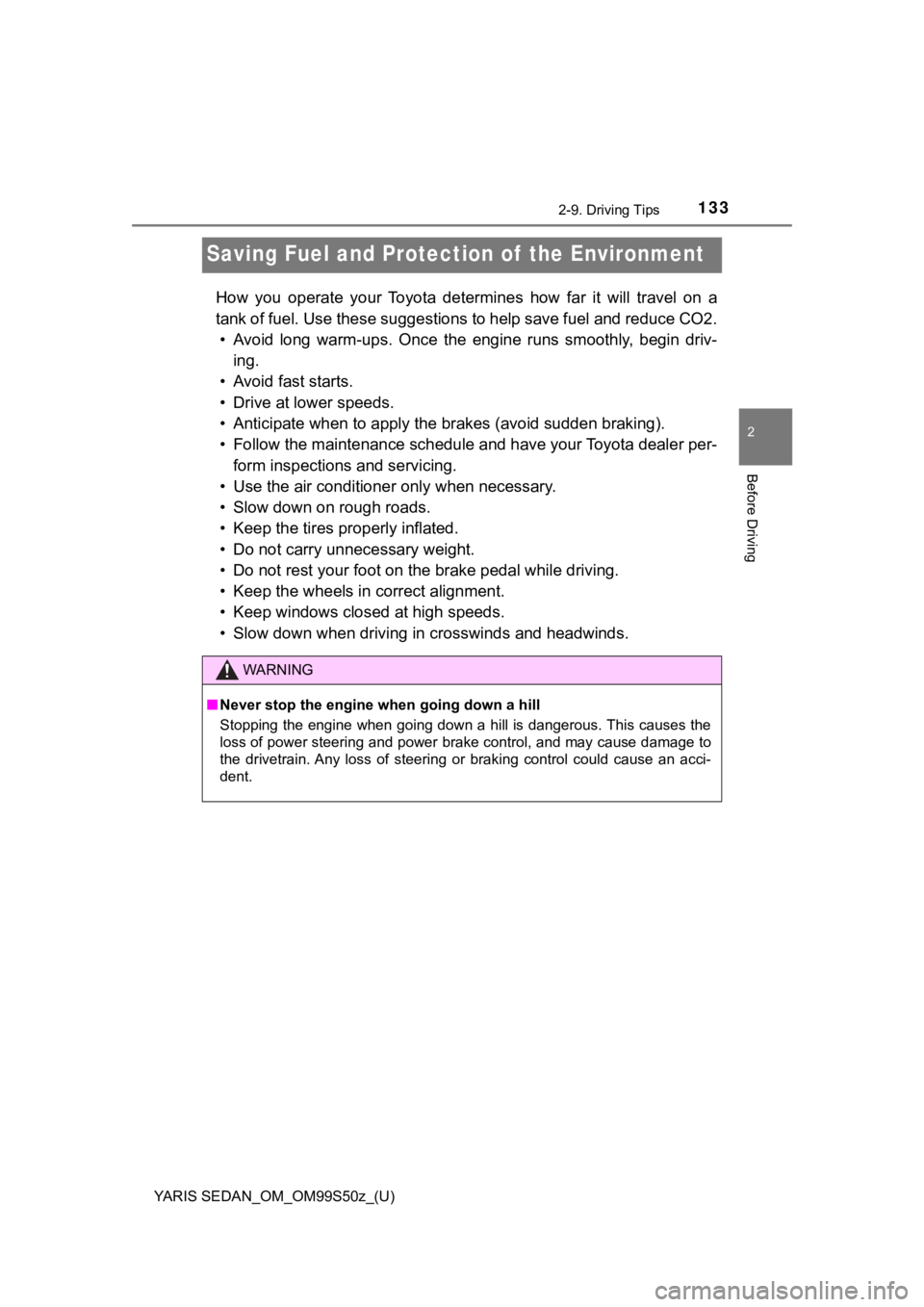
133
YARIS SEDAN_OM_OM99S50z_(U)
2-9. Driving Tips
2
Before Driving
Saving Fuel and Protection of the Environment
How you operate your Toyota determines how far it will travel o n a
tank of fuel. Use these suggesti ons to help save fuel and reduce CO2.
• Avoid long warm-ups. Once the engine runs smoothly, begin driv -
ing.
• Avoid fast starts.
• Drive at lower speeds.
• Anticipate when to apply the br akes (avoid sudden braking).
• Follow the maintenance schedule and have your Toyota dealer pe r-
form inspections and servicing.
• Use the air conditioner only when necessary.
• Slow down on rough roads.
• Keep the tires properly inflated.
• Do not carry unnecessary weight.
• Do not rest your foot on the brake pedal while driving.
• Keep the wheels in correct alignment.
• Keep windows clos ed at high speeds.
• Slow down when driving in crosswinds and headwinds.
WARNING
■ Never stop the engine when going down a hill
Stopping the engine when going down a hill is dangerous. This c auses the
loss of power steering and power brake control, and may cause d amage to
the drivetrain. Any loss of steering or braking control could c ause an acci-
dent.
Page 134 of 600
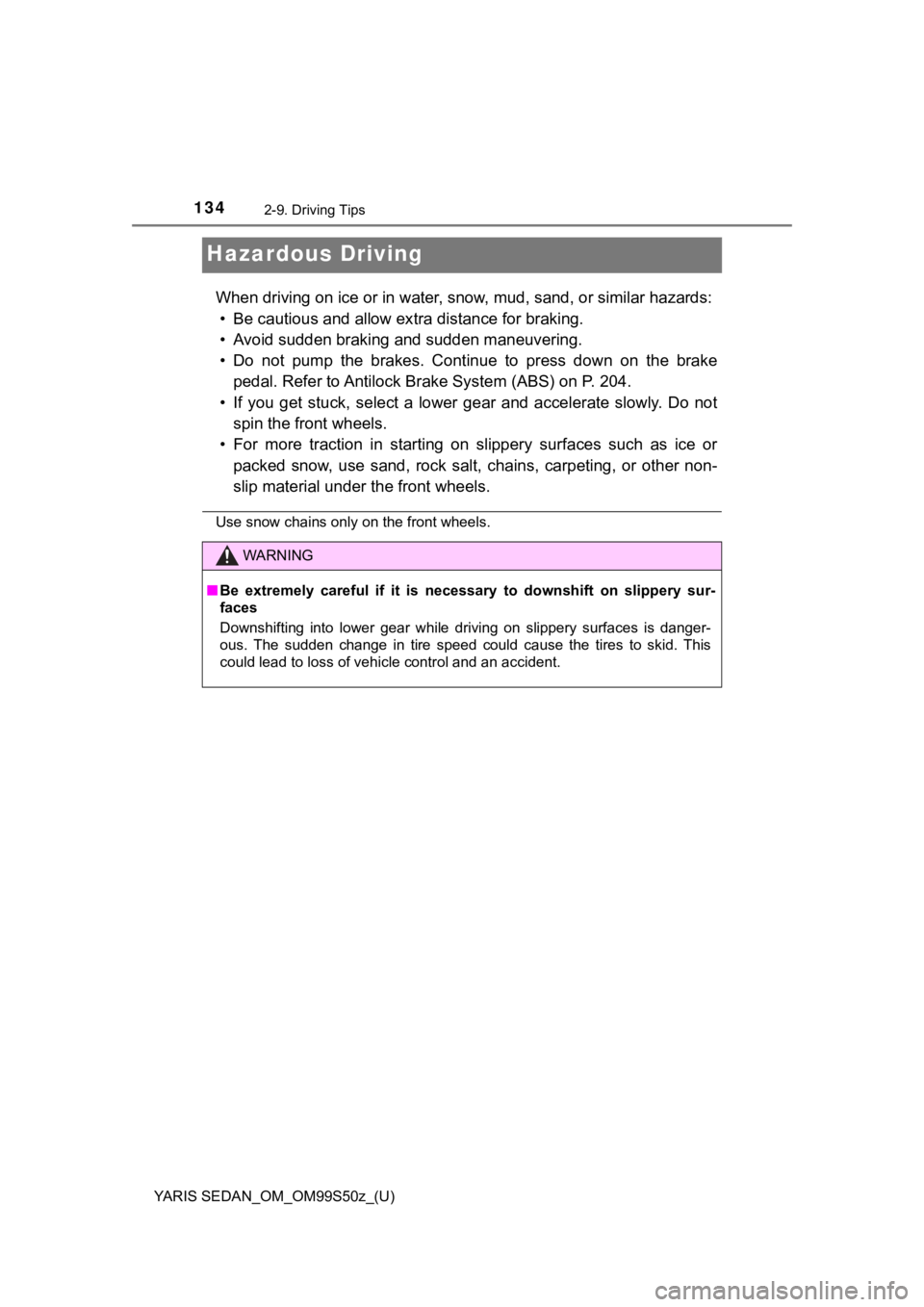
134
YARIS SEDAN_OM_OM99S50z_(U)
2-9. Driving Tips
Hazardous Driving
When driving on ice or in water, snow, mud, sand, or similar hazards:
• Be cautious and allow ex tra distance for braking.
• Avoid sudden braking and sudden maneuvering.
• Do not pump the brakes. Continue to press down on the brake pedal. Refer to Antilock Brake System (ABS) on P. 204.
• If you get stuck, select a lower gear and accelerate slowly. D o not
spin the front wheels.
• For more traction in starting on slippery surfaces such as ice or
packed snow, use sand, rock sal t, chains, carpeting, or other non-
slip material under the front wheels.
Use snow chains only on the front wheels.
WARNING
■ Be extremely careful if it is necessary to downshift on slipper y sur-
faces
Downshifting into lower gear while driving on slippery surfaces is danger-
ous. The sudden change in tire speed could cause the tires to s kid. This
could lead to loss of vehicle control and an accident.
Page 138 of 600
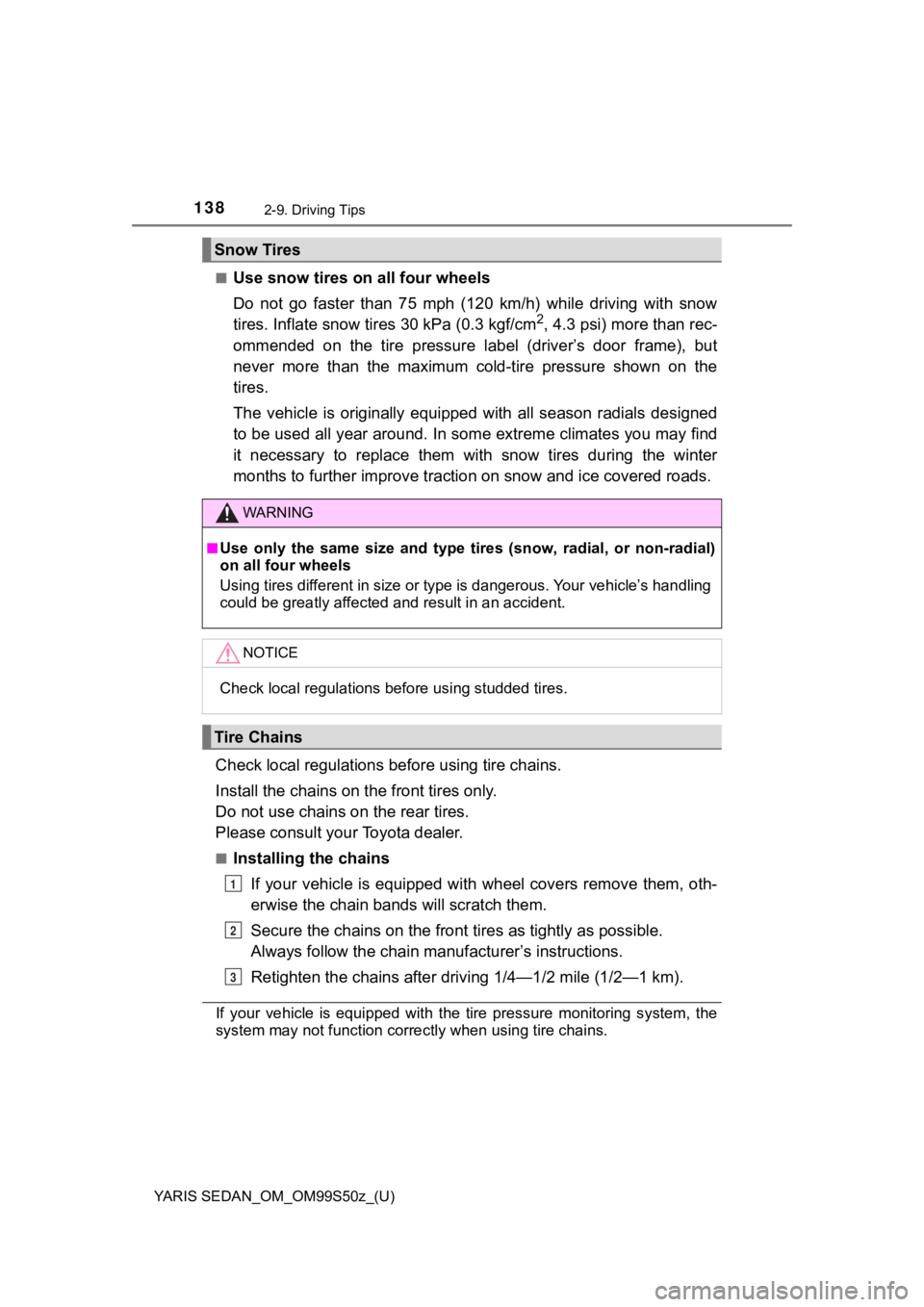
138
YARIS SEDAN_OM_OM99S50z_(U)
2-9. Driving Tips
■Use snow tires on all four wheels
Do not go faster than 75 mph (120 km/h) while driving with snow
tires. Inflate snow tires 30 kPa (0.3 kgf/cm
2, 4.3 psi) more than rec-
ommended on the tire pressure label (driver’s door frame), but
never more than the maximum cold-tire pressure shown on the
tires.
The vehicle is originally equipped with all season radials desi gned
to be used all year around. In some extreme climates you may fi nd
it necessary to replace them wit h snow tires during the winter
months to further improve tracti on on snow and ice covered road s.
Check local regulations before using tire chains.
Install the chains on the front tires only.
Do not use chains o n the rear tires.
Please consult your Toyota dealer.
■Installing the chains
If your vehicle is equipped with wheel covers remove them, oth-
erwise the chain bands will scratch them.
Secure the chains on the front tires as tightly as possible.
Always follow the chain manuf acturer’s instructions.
Retighten the chains after dri ving 1/4—1/2 mile (1/2—1 km).
If your vehicle is equipped with the tire pressure monitoring s ystem, the
system may not function correctly when using tire chains.
Snow Tires
WARNING
■Use only the same size and type tires (snow, radial, or non-rad ial)
on all four wheels
Using tires different in size or type is dangerous. Your vehicl e’s handling
could be greatly affected and result in an accident.
NOTICE
Check local regulations before using studded tires.
Tire Chains
1
2
3
Page 142 of 600
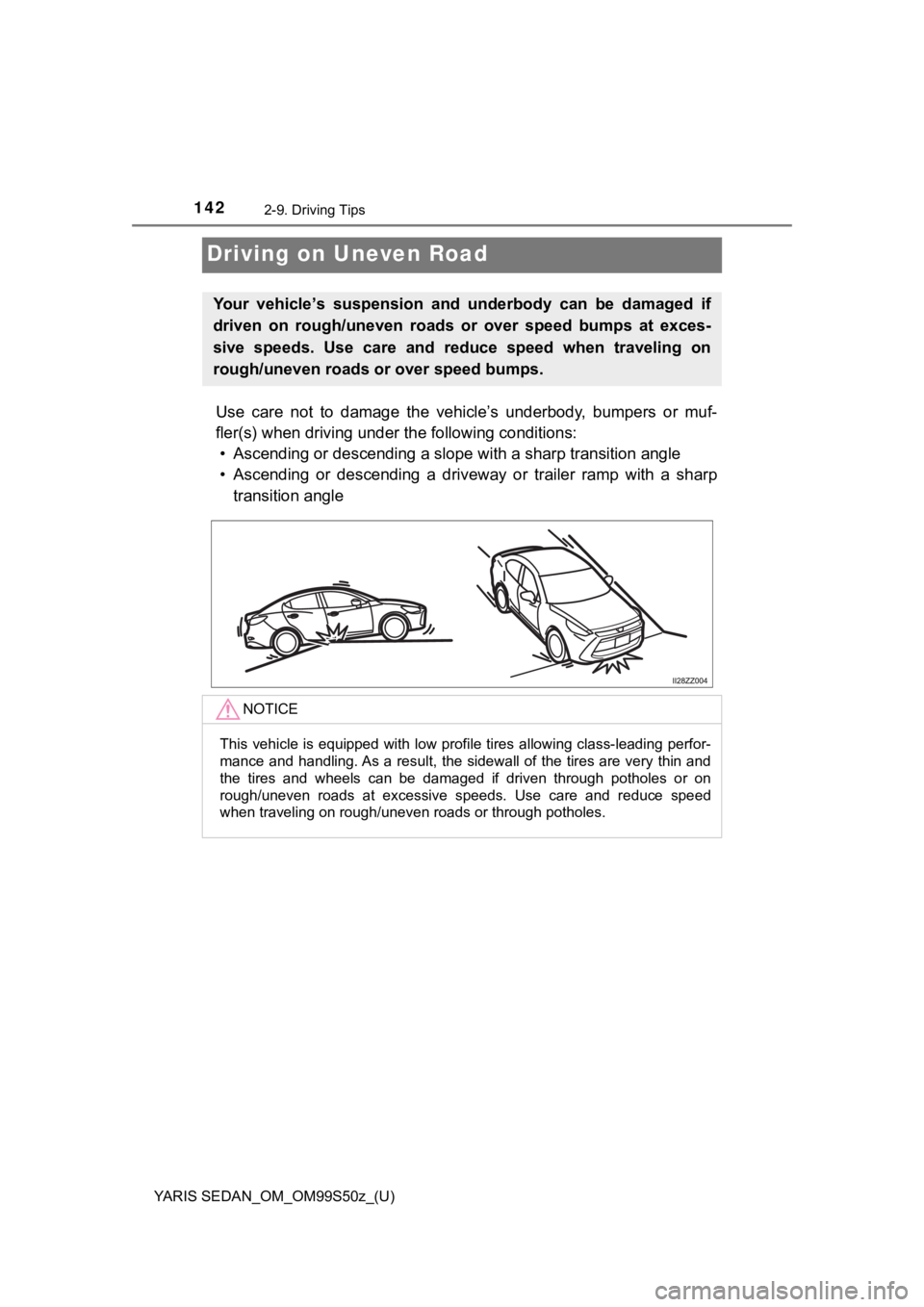
142
YARIS SEDAN_OM_OM99S50z_(U)
2-9. Driving Tips
Driving on Uneven Road
Use care not to damage the vehicle’s underbody, bumpers or muf-
fler(s) when driving under the following conditions:
• Ascending or descending a slope with a sharp transition angle
• Ascending or descending a drivew ay or trailer ramp with a sharp
transition angle
Your vehicle’s suspension and underbody can be damaged if
driven on rough/uneven roads or over speed bumps at exces-
sive speeds. Use care and reduce speed when traveling on
rough/uneven roads or over speed bumps.
NOTICE
This vehicle is equipped with low profile tires allowing class- leading perfor-
mance and handling. As a result, the sidewall of the tires are very thin and
the tires and wheels can be damaged if driven through potholes or on
rough/uneven roads at excessive speeds. Use care and reduce spe ed
when traveling on rough/uneven roads or through potholes.
Page 166 of 600
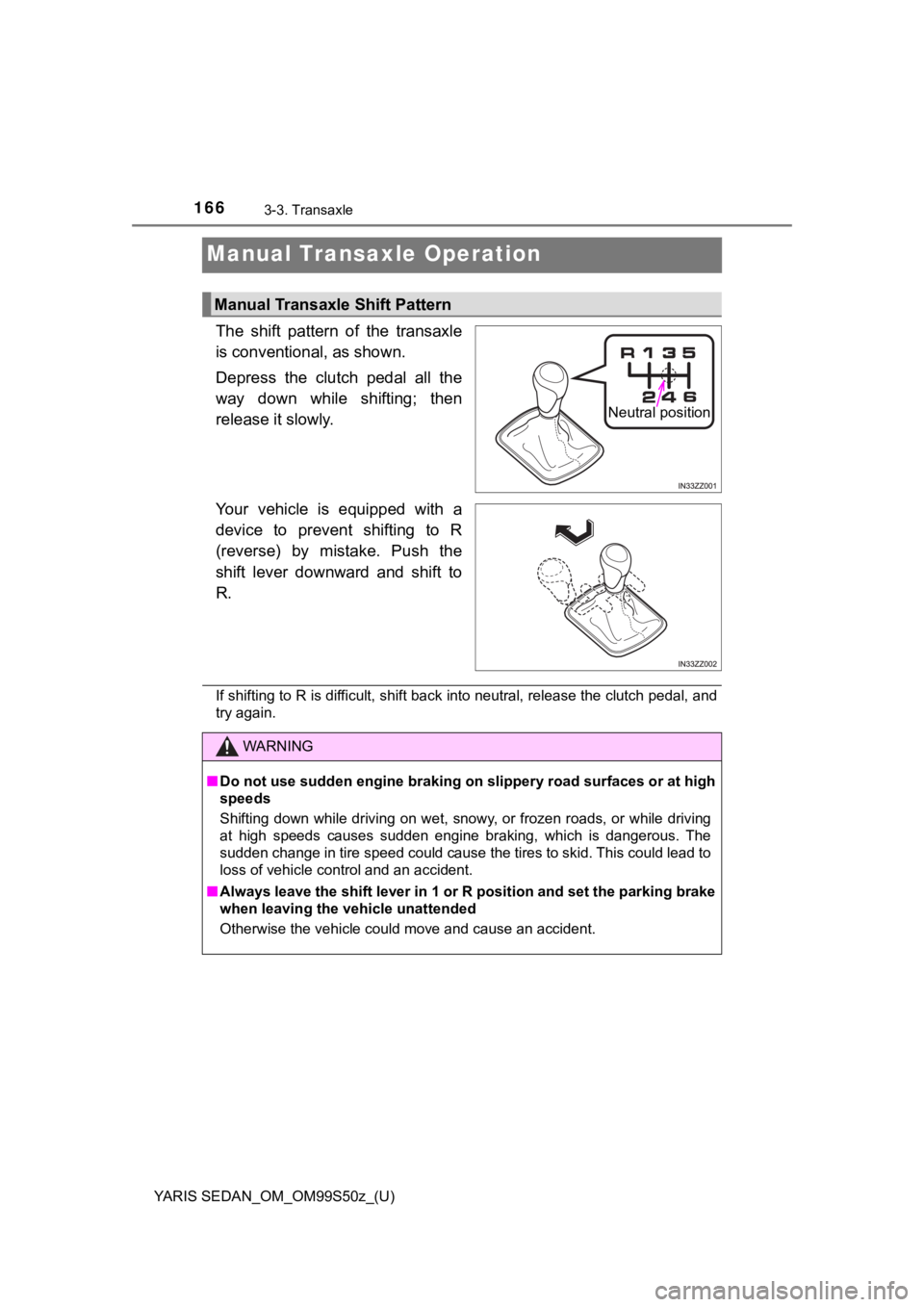
166
YARIS SEDAN_OM_OM99S50z_(U)
3-3. Transaxle
Manual Transaxle Operation
The shift pattern of the transaxle
is conventional, as shown.
Depress the clutch pedal all the
way down while shifting; then
release it slowly.
Your vehicle is equipped with a
device to prevent shifting to R
(reverse) by mistake. Push the
shift lever downward and shift to
R.
If shifting to R is difficult, shift back into neutral, release the clutch pedal, and
try again.
Manual Transaxle Shift Pattern
Neutral position
WARNING
■Do not use sudden engine braking on slippery road surfaces or at high
speeds
Shifting down while driving on wet, snowy, or frozen roads, or while driving
at high speeds causes sudden engine braking, which is dangerous . The
sudden change in tire speed could cause the tires to skid. This could lead to
loss of vehicle control and an accident.
■ Always leave the shift lever in 1 or R position and set the par king brake
when leaving the vehicle unattended
Otherwise the vehicle could move and cause an accident.
Page 179 of 600

YARIS SEDAN_OM_OM99S50z_(U)
1793-3. Transaxle
3
When Driving
■Manually shifting up
●When driving slowly, the gears may not shift up.
● In manual shift mode, do not run the engine with the tachometer needle in
the RED ZONE. When the engine rpm is high, a gear may shift up automat-
ically to protect the engine.
● When depressing the accelerator fully, the transaxle will shift to a lower
gear, depending on vehicle speed.
■ Manually shifting down
●When driving at high speeds, the gear may not shift down.
● During deceleration, the gear may automatically shift down depending on
vehicle speed.
● When depressing the accelerator fully, the transaxle will shift to a lower
gear, depending on vehicle speed.
WARNING
■Do not use engine braking on slippery road surfaces or at high speeds
Shifting down while driving on wet, snowy, or frozen roads, or while driving
at high speeds causes sudden engine braking, which is dangerous . The
sudden change in tire speed could cause the tires to skid. This could lead to
loss of vehicle control and an accident.
Page 204 of 600
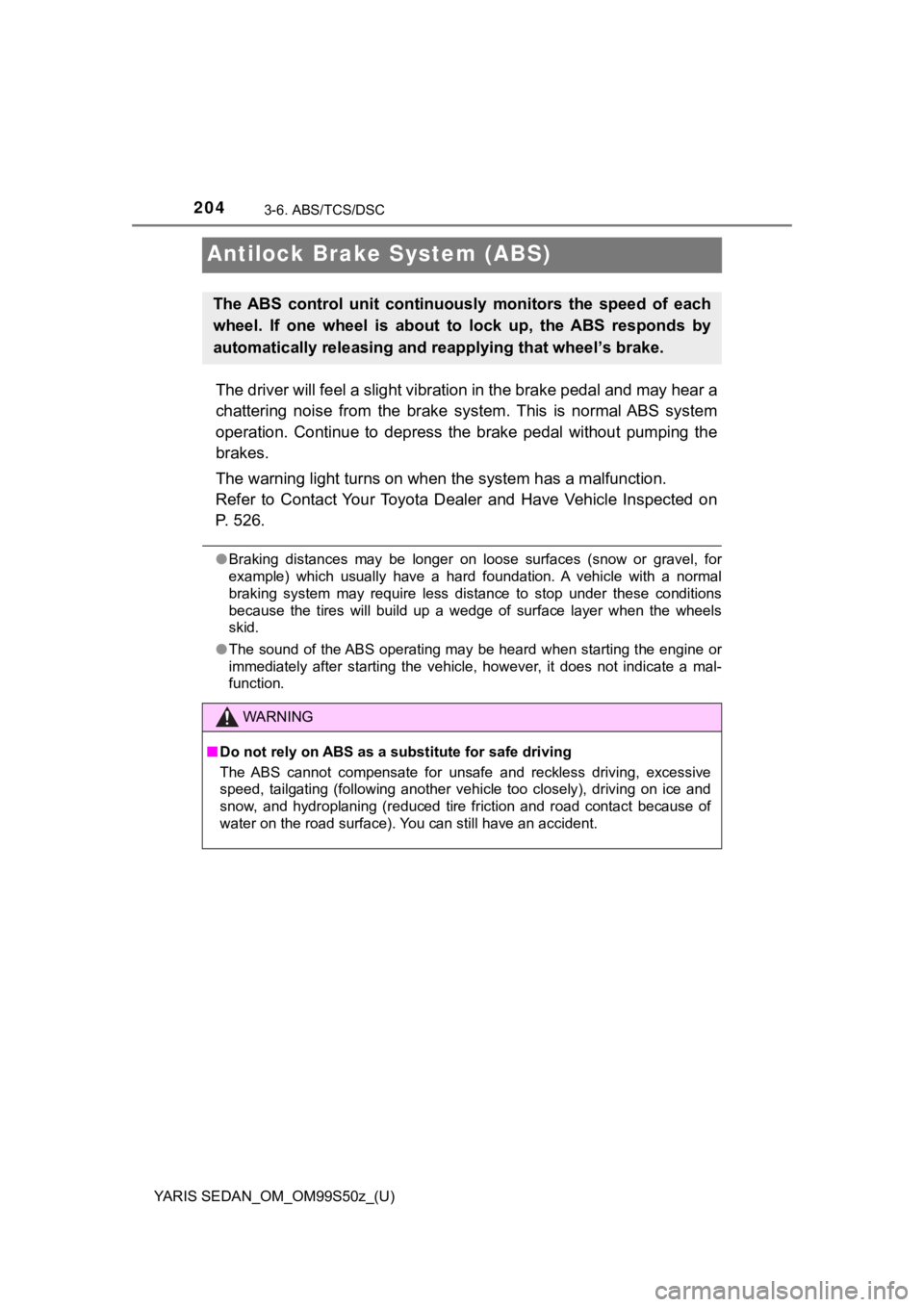
204
YARIS SEDAN_OM_OM99S50z_(U)
3-6. ABS/TCS/DSC
Antilock Brake System (ABS)
The driver will feel a slight vibration in the brake pedal and may hear a
chattering noise from the brake system. This is normal ABS syst em
operation. Continue to depress the brake pedal without pumping the
brakes.
The warning light turns on when the system has a malfunction.
Refer to Contact Your Toyota Dealer and Have Vehicle Inspected on
P. 526.
● Braking distances may be longer on loose surfaces (snow or grav el, for
example) which usually have a hard foundation. A vehicle with a normal
braking system may require less distance to stop under these co nditions
because the tires will build up a wedge of surface layer when t he wheels
skid.
● The sound of the ABS operating may be heard when starting the engine or
immediately after starting the vehicle, however, it does not in dicate a mal-
function.
The ABS control unit continuously monitors the speed of each
wheel. If one wheel is about to lock up, the ABS responds by
automatically releasing and reapplying that wheel’s brake.
WARNING
■ Do not rely on ABS as a su bstitute for safe driving
The ABS cannot compensate for unsafe and reckless driving, exce ssive
speed, tailgating (following another vehicle too closely), driv ing on ice and
snow, and hydroplaning (reduced tire friction and road contact because of
water on the road surface). You can still have an accident.